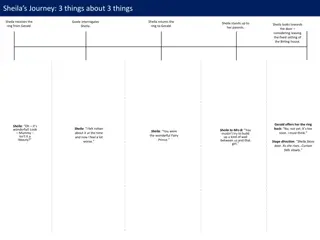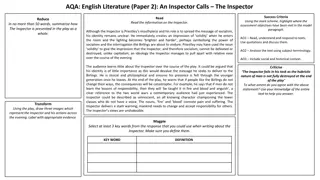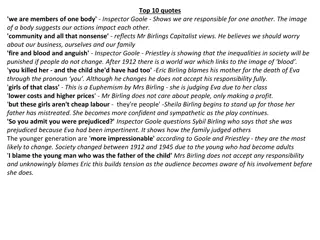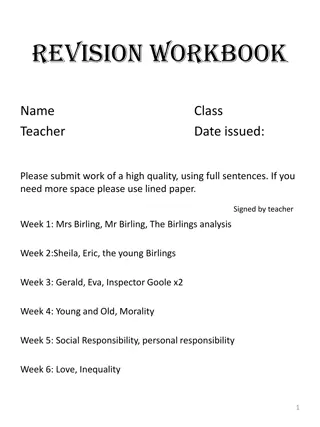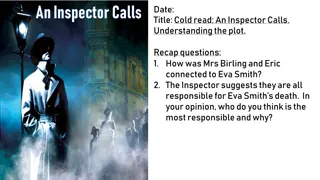Historical Context of "An Inspector Calls" Play
The play "An Inspector Calls" is set in 1912, just before the Titanic disaster and on the brink of World War One. The historical context depicts the societal class structure, Britain's imperial stature, labor unrest, and the emergence of the Labour Party. The play's setting reflects the prevailing sentiments and upheavals of the time, providing a backdrop for the unfolding drama.
Download Presentation

Please find below an Image/Link to download the presentation.
The content on the website is provided AS IS for your information and personal use only. It may not be sold, licensed, or shared on other websites without obtaining consent from the author.If you encounter any issues during the download, it is possible that the publisher has removed the file from their server.
You are allowed to download the files provided on this website for personal or commercial use, subject to the condition that they are used lawfully. All files are the property of their respective owners.
The content on the website is provided AS IS for your information and personal use only. It may not be sold, licensed, or shared on other websites without obtaining consent from the author.
E N D
Presentation Transcript
An Inspector Calls Setting the play in the historical context
1912: when the play is set The play is set just prior to the Titanic disaster in April 1912. The Titanic reflected the class structure at the time. The Titanic reflected the confidence and certainty about Britain- the ship that would never sink.
1912: when the play is set Only two years before the start of World War One: Just because the Kaiser makes a speech or two, or a few German officers have too much to drink you ll hear some people say that war s inevitable. And to that I say fiddlesticks! The Germans don t want war. Nobody wants war, except some half- civilised folks in the Balkans.
1912: when the play is set Britain is at the height of its empire. Britain has an empire on which the sun never sets . Britain s manufacturing industry exports across the globe. Britain s navy leads the world.
1912: when the play is set Britain is experiencing labour unrest and strikes. Last month, just because the miners came out on strike, there s a lot of wild talk about possible labour trouble in the near future . Miners Strike, 1912 Was a national strike Nearly 1m miners took part Lasted 37 days Led to a minimum wage being introduced for miners.
1912: When the play is set In 1900 the Labour Party was founded. This was the first political party that was for working people. By 1910 the Labour Party had 42 MPs in Parliament. The Labour Party was formed from several political groups. Some of the groups were Socialist and were inspired by the ideas of Karl Marx. They wanted to created a fairer, more equal society. Karl Marx saw the factory owners as the enemy of the working class the capitalists. Marx had expected a revolution would take place in countries in Britain and the workers would run the country. We employers at last are coming together to see that our interests- and the interest of Capital are properly protected.
1946: when the play was first performed The Second World War had just ended. An election took place in July 1945. Britain had a Labour Government, led by Clement Attlee. The Labour Party is a Socialist party and proud of it. There were high expectations that Britain would change. The end of the War was a chance to re-build Britain. The Labour Party promised to nationalise coal, gas, electricity, the railways, iron and steel. The military vote overwhelmingly pro-Labour and wanted change and a better civilian life. The Welfare State was born in 1946.
The Welfare State 1946 The National Insurance Act, 1946 The National Health Services Act 1946 The Industrial Injuries Act 1946 National Assistance Act The Appointed Day was 5 July 1948 The aim was to provide a service that cared for all people from cradle to grave .
What did the Welfare State replace? The Poor Law System with the Workhouse and the Poor Law Guardians. You had to pay to see a doctor. There was a benefit system before the World War Two, but it was not comprehensive. I had my daughter before the 1939 war. At the maternity home we had to pay a 2 deposit and another 10 shillings when she came. I got up at six in the morning and said to my husband, Come on, we re ready . I had to walk down to the maternity home with a hole in my shoe
William Beveridge and the Welfare State By 1939 public opinion was firmly in favour of a major expansion of social services. During wartime demands grew. People were hoping for better world after World War Two and the depression of the 1930s. During the war, barriers between different social classes were broken down fighting in the armed forces, Home Guard, sharing shelters etc. The war forced the government to intervene more in hospital care, diet etc. The evacuation of 1.5m women and children opened people s eyes to the poverty that existed.
William Beveridge and the Welfare State In practically every batch of children there were some who suffered from head-lice, skin diseases and bed-wetting Some children had never slept in a bed before One boy had never had a bath before.. Few children would eat food that demanded the use of teeth-could only eat with a teaspoon. One girl of five remarked that she would like to have beer and cheese for supper.. Some children had never used a knife and fork From National Federation of Women s Institutes, 1941
William Beveridge and the Welfare State 1942 publication of the Beveridge Plan. Senior Civil Servant who had been involved in social policy for many years. In the introduction to the Report he wrote: A revolutionary moment in the world s history is a time for revolutions, not for patching Social insurance should be treated as one part only of a comprehensive policy of social progress it is an attack on Want. But Want is only one of five giants
The Five Giants and from Cradle to Grave Want Disease Ignorance Squalor Idleness Beveridge s scheme would provide: Benefits for the unemployed, sick and disabled Pensions and benefits for old people, widows and orphans Funeral Grants Maternity Benefits
The Reconstruction Committee 1944 Education Act: set up three types of schools: grammar, secondary modern and technical schools. School leaving age was raised to 15. 1946 New Towns Act 1946 The National Insurance Act, 1946 The National Health Services Act 1946 The Industrial Injuries Act 1946 National Assistance Act Sat from 1943-1945 Brought out a series of papers covering major changes in: Education Health Employment policy Social Insurance Housing
Attlee and the Labour Government The Welfare State 1948 beginning of the National Health Service Compulsory Education to 15 and selection at 11. Post-war housing programme Independence for India in 1947 Independence for Myanmar (Burma)and Sri Lanka in 1948





